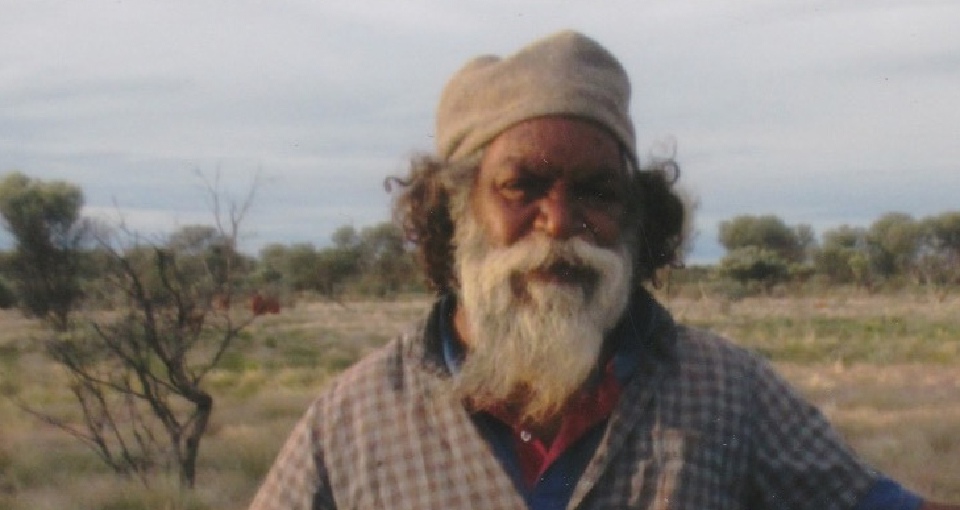Warlimpirrnga Tjapaltjarri

DOB:
c.1958
Born:
Tjuurlnga in the Angus Hills, east of Kiwirrkurra
Language: Pintupi
Community: Kiwirrkura, WA
Warlimpirrnga Tjapaltjarri was the son of Papalya Nangala and Waku Tjungurrayi, an old man who had three wives (Papalya and two of her sisters). They lived out in the desert, avoiding any contact with Westerners.
He grew up following the traditional lifestyle of the Western Desert people in the country west of Wilkinkarra (Lake Mackay). After his father's death, when Warlimpirnnga was about five years old, Waku's place as senior man of the group was taken by Lanti Tjapanangka, who married Waku's widows and continued to enforce the group's isolation.
A few years after Lanti died, the twice-widowed sisters sent off Warlimpirrnga (now in his mid 20s) and his older half-brother Piyirti to search for their long-lost relatives.
In October 1984, the brothers encountered Pinta Pinta Tjapanangka and his son Matthew trying to fix a flat tyre at their Mt Webb outstation, just outside of the newly established Pintupi homelands community of Kiwirrkurra.
The subsequent arrival of the family group of nine in Kiwirrkurra made national headlines. They became known as the 'Pintupi Nine' or 'The Lost Tribe'. Up to this point, Warlimpirrnga had had no contact with Europeans and their way of living.
One night, about two months after arriving at Kiwirrkurra, Piyirti crept away from his camp and walked back into the desert with his spear. His fate is the enduring mystery.
Meantime, Warlimpirrnga and his brothers were taken under the watchful guidance of Dr. George Tjapaltjarri, a 'medicine man' of high regard who continued their instruction through the 'law'.
After observing Dr. George and other artists at work, Warlimpirrnga approached Daphne Williams of Papunya Tula Artists, with the request that he be allowed to paint. Other artists instructed him in the use of paint and canvas, and he completed his first painting in 1987. His first eleven paintings were exhibited at Gallery Gabrielle Pizzi in 1988 and acquired as a lot by the National Gallery of Victoria.
After painting for some time, Warlimpirrnga began teaching his brothers Walala and Thomas Tjapaltjarri to paint, and by 1996 Walala had taken to accompanying his brother on trips to Alice Springs. All three brothers, as well as Dr. George, began painting for Gallery Gondwana during the late 1990's. This was due in large part to their personal relationship with Gallery Gondwana Manager Brice Ponsford, who had worked for Papunya Tula in Kiwirrkurra when they first arrived in the community a decade earlier.
By 1999 Dr. George painted less and less frequently as his eyesight began to fail. Walala, preferring his independence, lived in Alice Springs and Katherine, where he painted for a number of independent dealers. Warlimpirrnga, however, tired of life too far from his family and homeland and returned to paint principally for the Papunya Tula art centre.
Since then, he has appeared in many exhibitions. In 2000, he travelled to Sydney with a group of four men from Kiwirrkurra to make a ground painting at the Art Gallery of New South Wales for the opening of 'Papunya Tula: Genesis and Genius'. In 2012, he was amongst a small group of Australian artists to have work included in DOCUMENTA (13) in Kassel, Germany.
In 2015, Warlimpirrnga had his first solo exhibition in the United States, when 'Maparntjarra' opened at Salon 94 In New York City. The New York Times and The Wall Street Journal both wrote articles about the ground-breaking show. The show represented a critical first step in the re-emergence of Australian Aboriginal art in the American market. It also marked the start of the second phase of growth of Warlimpirrnga’s reputation as a leading Aboriginal artist.
Warlimpirrnga paints Snake and Tingari Dreaming stories for his country, including the sites of Marawa and Kanapilya and the salt lake and soakage area of Kalparti. Other recurrent subjects are Minatapinya, a large swamp south of Marawa, where Tingari men camped as they made their way east towards Wilkinkarra, as well as Malu (Kangaroo) Dreaming.
Viewing his art is an extraordinary visual experience, and thus it is no surprise that he has been at the forefront of the Men's Painting Movement at Papunya for decades.
The designs featured in his paintings display the rich optical effect that is a feature of many western desert Aboriginal paintings. Lozenge shapes appear to gaze from the almost hypnotic field of dotted lines, resembling the effects of wind on the desert sandhills.
His earlier paintings depict segments of the Tingari cycle in the classic Pintupi style. This vast, undulating religious cycle re-enacted in men's and women's ceremonies, tells of the journeyings of large groups of ancestral beings and novices across the country.
Fred R. Myers, an anthropologist at New York University, who has studied the Pintupi and their art since the early 1970s, explains that "he is highly respected in his homeland for his knowledge and experience, and his paintings of his stories are really very much tied to that respect."
Warlimpirrnga's work can be found in many public and corporate collections, including the the National Gallery of Victoria, Art Gallery of New South Wales, Musee National des Arts Africains et Oceaniens, Paris, and the Kelton Foundation, USA.
He has four children to an earlier relationship with Yalti Napangati and lives in Kiwirrkurra Community.
Copyright Kate Owen Gallery 20 August 2020
